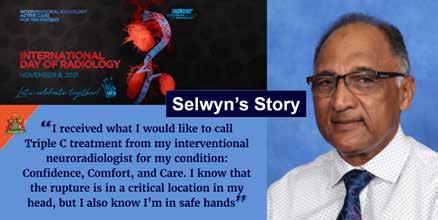
5 minute read
The Transformative Potential of the Interventional Radiology Specialties for RANZCR
from Inside News December 2021
by RANZCR
The Importance of Recognising IR and INR as Clinical Specialties
Yesterday, at one of the hospitals where I work, a patient who was critically unstable had a life-saving procedure to stop major bleeding in their chest from a tiny artery just below their aorta.
At a hospital down the road, another patient who presented earlier that day suffering a stroke is now sitting up in bed conversing with her daughter.
In hospitals around the country, select groups of patients had their tumours cured without undergoing major surgery or unpleasant chemotherapy. Similarly, women with symptomatic uterine fibroids, men suffering from prostate enlargement and elderly patients with debilitating vertebral fractures all had their problems successfully managed without the need for an operation.
While IRs and INRs are also specialist diagnostic radiologists, and many diagnostic radiologists expertly perform image-guided procedures, specialist qualified IRs and INRs possess technical capabilities and a clinical skillset additional to that of diagnostic radiology. Specialists in interventional radiology and interventional neuroradiology actively assess patients, evaluate potential treatment options, contribute to management decision, and perform image-guided procedures.
Like Artificial Intelligence, Digital Health and Tele-radiology, modern IR and INR practice presents many exciting opportunities for the College, with the potential to transform clinical radiology and the role of the radiologist. The clinical utility and considerable value that IR and INR bring to patient care, hospitals and the broader healthcare system adds a whole new dimension to the evolving face of the radiology profession that should be celebrated.
Supported by a growing evidence base, the capacity for minimally-invasive, image-guided procedures to save lives, cure disease or alleviate suffering better, faster and for less money than some other, traditional methods of treatment is only beginning to be realised by policy-makers and hospital administrators. In the era of Value-Based Healthcare, IR and INR are therefore well placed to capitalise on these strengths, presenting exciting opportunities for the College to embrace this expanding frontier, grow its brand and consolidate the importance and influence of clinical radiology within modern health care.
The College is well advanced with its planned application for formal specialty recognition of IR and INR by the Medical Board of Australia and the Medical Council of New Zealand, which will provide a tremendous boost for all of clinical radiology. This process has emphasised the need for dedicated governance structures and resources within the College to support specialty training and practice in IR and INR, alongside existing procedural radiology. Far from dividing the profession, such a development will expand the foundations of the College and consolidate the important links between diagnostic and interventional radiology, allowing specialist IRs and INRs to train, qualify and practise alongside other procedural radiologists who perform expert image-guided procedures. Links to diagnostic radiology also remain crucial for the IR and INR specialist, with advanced image interpretation being a core component of radiological guided procedures and essential for making real-time treatment decisions. It is this that sets IRs and INRs apart from other endovascular specialties.
This adds a whole new dimension to the College, where the value of an interventional radiologist or interventional neuroradiologist is not just measured in the number of studies reported but in the number of consults performed, treatments delivered, benefits gained and problems solved.
These are specialties where radiologists don’t just get up from their workstations to perform the occasional injection or biopsy, but spend their days consulting and reviewing patients, receiving referrals and performing a growing range of minimally invasive, image-guided procedures. In this regard, IR and INR overlap with both radiation oncology and clinical radiology, and recognition of their specialty status would be an enduring credit to the College.

The attributes of IRs and INRs merely extend the already very long list of benefits that clinical radiology brings to the table. Just as AI has the potential to augment radiology and provide greater awareness of the role that radiologists play in patient care, so too does IR and INR afford an opportunity to pull radiologists out of the proverbial dark rooms and into the clinical and therapeutic consciousness of referrers and patients. Such an advent is in the best interests of all College members and simply an opportunity that we cannot afford to miss. The alternative is to repeat the mistakes of the past and acquiesce ground that should so obviously rest within the domain of clinical radiology.
It is the goal of the IRC that a current first year radiology registrar will have available to them, should they choose, a clear pathway from FRANZCR to advanced training in IR or INR that will lead to a formal qualification, a recognised specialist title and acknowledgement by their peers of the important role they play in a modern health system. This will help the College, our colleagues, our patients and the hospitals and health services for which we work, value the importance of IRs and INRs providing essential care for patients yesterday, today and tomorrow.
Dr Nick Brown
Chair, Interventional Radiology Committee










